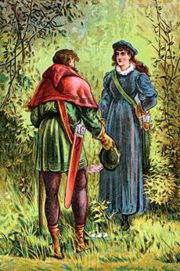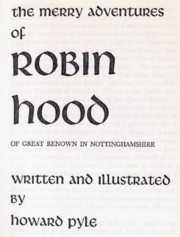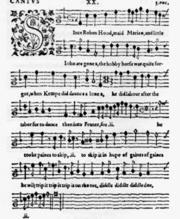Robin Hood
2008/9 Schools Wikipedia Selection. Related subjects: British History 1500-1750
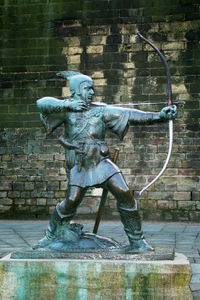
Robin Hood is a figure in archetypal English folk tales, whose story originates from medieval times. In popular culture he is painted as a man known for robbing the rich to provide for the poor and fighting against injustice and tyranny. His band consists of "seven score" group of fellow outlawed yeomen – called his " Merry Men". He has been the subject of numerous movies, television series, books, comics and plays.
In popular culture Robin Hood and his band's tales are usually associated with the area Sherwood Forest and Nottinghamshire, though most historians point towards him being a Yorkshireman. Historically his birthplace is said to be Loxley in South Yorkshire, while his grave is claimed to be at Kirklees Priory in West Yorkshire.
In the oldest legends the outlaw's enemy is the sheriff due simply to his profession, but in later versions the sheriff is despotic and gravely abuses his position, appropriating land, levying excessive taxation, and persecuting the poor. In some tales the antagonist is Prince John, based on the historical John of England, who is seen as the unjust usurper of his pious brother Richard the Lionheart. In the oldest versions surviving, Robin Hood is a yeoman, but in some later versions he is described as a nobleman and Lord of the Manor of Loxley (or Locksley), usually designated Robin of Loxley, who was unjustly deprived of his lands.
In other stories, he has served in the crusades, returning to England to find his lands pillaged by the dastardly sheriff. In some tales he is the champion of the people, fighting against corrupt officials and the oppressive order that protects them, while in others he is an arrogant and headstrong rebel, who delights in bloodshed, cruelly slaughtering and beheading his victims.
Despite the fact that most historians and experts link Hood to real life places that still exist today, a subsection argue that his tales (although not the very earliest) have some similarities to other outlaws such as Hereward the Wake, Eustace the Monk and Fulk FitzWarin. The latter of whom was a Norman noble who was disinherited and became an outlaw and an enemy of John of England.
Ballads and tales
The earliest surviving Robin Hood text is " Robin Hood and the Monk". This is preserved in Cambridge University manuscript Ff.5.48, which was written shortly after 1450. It contains many of the elements still associated with the legend, from the Nottingham setting to the bitter enmity between Robin and the local sheriff.
The first printed version is A Gest of Robyn Hode (c.1475), a collection of separate stories which attempts to unite the episodes into a single continuous narrative. After this comes " Robin Hood and the Potter", contained in a manuscript of c.1503. "The Potter" is markedly different in tone from "The Monk": whereas the earlier tale is 'a thriller' the latter is more comic, its plot involving trickery and cunning rather than straightforward force. The difference between the two texts recalls Bower's claim that Robin-tales may be both 'comedies and tragedies'. Other early texts are dramatic pieces such as the fragmentary Robyn Hod and the Shryff off Notyngham (c.1472). These are particularly noteworthy as they show Robin's integration into May Day rituals towards the end of the Middle Ages.
In many respects, the character of Robin in these first texts differs from his later incarnations. While in modern stories Robin Hood typically pursues justice, and the Merry Men are a proto-democracy, this sense of generosity and egalitarianism is absent from the medieval and Early Modern sources. Robin is often presented as vengeful and self-interested, meting out barbaric punishments to his own enemies, but rarely fighting on the behalf of others. Nothing is stated about 'giving to the poor', although Robin does make a large loan to an unfortunate knight. Furthermore, even within his band, ideals of equality are generally not in evidence. In the early ballads Robin's men usually kneel before him in strict obedience: in A Gest of Robyn Hode the king even observes that "His men are more at his byddynge/Then my men be at myn". Their social status, as yeomen, is shown by their weapons; they use swords rather than quarterstaffs. The only character to use a quarterstaff in the early ballads is the potter, and Robin Hood does not take to a staff until the eighteenth century Robin Hood and Little John. And rather than being deprived of his lands by the villainous Sheriff of Nottingham, when an origin story for Robin appears, he takes to 'the greenwood' after killing royal foresters for mocking him (see Robin Hood's Progress to Nottingham).
While he is sometimes described as a figure of peasant revolt, the details of his legends do not match this. He is not a peasant but an archer, and his tales make no mention of the complaints of the peasants, such as oppressive taxes. He appears not so much as a revolt against societal standards as an embodiment of them, being generous, pious, and courteous, opposed to stingy, worldly, and churlish foes. His tales glorified violence, but did so in a violent era. While he fights with royal officials, his loyalty to the king himself is strong.
Although the term "Merry Men" belongs to a later period, the ballads do name several of Robin's companions. These include Will Scarlet (or Scathlock), Much the Miller's Son, and Little John — who was called "little" as a joke, as he was quite the opposite. Even though the band is regularly described as being over a hundred men, usually only three or four are specified. Some appear only once or twice in a ballad: Will Stutly in Robin Hood Rescuing Will Stutly and Robin Hood and Little John; David of Doncaster in Robin Hood and the Golden Arrow; Gilbert with the White Hand in A Gest of Robyn Hode; and Arthur a Bland in Robin Hood and the Tanner. Many later adapters developed these characters. Guy of Gisbourne also appeared in the legend at this point, as was another outlaw Richard the Divine who was hired by the sheriff to hunt Robin Hood, and who dies at Robin's hand.
Printed versions of the Robin Hood ballads, generally based on the Gest, appear in the early 16th century, shortly after the introduction of printing in England. Later that century Robin is promoted to the level of nobleman: he is styled Earl of Huntington, Robert of Locksley, or Robert Fitz Ooth. In the early ballads, by contrast, he was a member of the yeoman classes, a common freeholder possessing a small landed estate.
In the fifteenth century, Robin Hood became associated with May Day celebrations; people would dress as Robin or as other members of his band for the festivities. This was not practiced throughout England, but in regions where it was practiced, lasted until Elizabethean times, and during the reign of Henry VIII, was briefly popular at court. This often put the figure in the role of a May King, presiding over games and processions, but plays were also performed with the characters in the roles. These plays could be enacted at "church ales", a means by which churches raised funds. A complaint of 1492, brought to the Star Chamber, accuses men of acting riotously by coming to a fair as Robin Hood and his men; the accused defended themselves on the grounds that the practice was a long-standing custom to raise money for churches, and they had not acted riotously but peaceably.
It is from this association that Robin's romantic attachment to Maid Marian (or Marion) stems. The naming of Marian may have come from the French pastoral play of c. 1280, the Jeu de Robin et Marion, although this play is unrelated to the English legends. Both Robin and Marian were certainly associated with May Day festivities in England (as was Friar Tuck), but these were originally two distinct types of performance — Alexander Barclay, writing in c.1500, refers to "some merry fytte of Maid Marian or else of Robin Hood" — but the characters were brought together. Marian did not immediately gain the unquestioned role; in Robin Hood's Birth, Breeding, Valor and Marriage, his sweetheart is 'Clorinda the Queen of the Shepherdesses'. Clorinda survives in some later stories as an alias of Marian.
The first allusions to Robin Hood as stealing from the rich and giving to the poor appear in the 16th century. However, they still play a minor role in the legend; Robin still is prone to waylaying poor men, such as tinkers and beggars.
In the 16th century, Robin Hood is given a specific historical setting. Up until this point there was little interest in exactly when Robin's adventures took place. The original ballads refer at various points to 'King Edward', without stipulating whether this is Edward I, Edward II, or Edward III. Hood may thus have been active at any point between 1272 and 1377. However, during the 16th century the stories become fixed to the 1190s, the period in which King Richard was absent from his throne, fighting in the crusades. This date is first proposed by John Mair in his Historia Majoris Britanniæ (1521), and gains popular acceptance by the end of the century.
Giving Robin an aristocratic title and female love interest, and placing him in the historical context of the true king's absence, all represent moves to domesticate his legend and reconcile it to ruling powers. In this, his legend is similar to that of King Arthur, which morphed from a dangerous male-centered story to a more comfortable, chivalrous romance under the troubadours serving Eleanor of Aquitaine. From the 16th century on, the legend of Robin Hood is often used to promote the hereditary ruling class, romance, and religious piety. The "criminal" element is retained to provide dramatic colour, rather than as a real challenge to convention.
In 1601 the story appears in a rare historical play chronicling the late twelfth century: "The Downfall of Robert, Earl of Huntingdon, afterwards called Robin Hood of merrie Sherwoode; with his love to chaste Matilda, the Lord Fitz-Walter's daughter, afterwards his fair Maid Marian." The seventeenth century introduced the minstrel Alan-a-Dale. He first appeared in a seventeenth century broadside ballad, and unlike many of the characters thus associated, managed to adhere to the legend. This is also the era in which the character of Robin became fixed as stealing from the rich to give to the poor.
In the eighteenth century, the stories become even more conservative, and develop a slightly more farcical vein. From this period there are a number of ballads in which Robin is severely "drubbed" by a succession of professionals, including a potter, a tanner, a tinker and a ranger. In fact, the only character who does not get the better of Hood is the luckless Sheriff. Yet even in these ballads Robin is more than a mere simpleton: on the contrary, he often acts with great shrewdness. The tinker, setting out to capture Robin, only manages to fight with him after he has been cheated out of his money and the arrest warrant he is carrying. In Robin Hood's Golden Prize, Robin disguises himself as a friar and cheats two priests out of their cash. Even when Robin is defeated, he usually tricks his foe into letting him sound his horn, summoning the Merry Men to his aid. When his enemies do not fall for this ruse, he persuades them to drink with him instead.
The continued popularity of the Robin Hood tales is attested by a number of literary references. In As You Like It, the exiled duke and his men "live like the old Robin Hood of England", while Ben Jonson produced the (incomplete) masque The Sad Shepheard, or a Tale of Robin Hood as a satire on Puritanism. Somewhat later, the Romantic poet John Keats composed Robin Hood. To A Friend and Alfred Lord Tennyson wrote a play The Foresters, or Robin Hood and Maid Marian, which was presented with incidental music by Sir Arthur Sullivan in 1892. Later still, T. H. White featured Robin and his band in The Sword in the Stone — anachronistically, since the novel's chief theme is the childhood of King Arthur.
The Victorian era generated its own distinct versions of Robin Hood. The traditional tales were often adapted for children, most notably in Howard Pyle's Merry Adventures of Robin Hood. These versions firmly stamp Robin as a staunch philanthropist, a man who takes from the rich to give to the poor. Nevertheless, the adventures are still more local than national in scope: while Richard's participation in the Crusades is mentioned in passing, Robin takes no stand against Prince John, and plays no part in raising the ransom to free Richard. These developments are part of the 20th century Robin Hood myth. The idea of Robin Hood as a high-minded Saxon fighting Norman Lords also originates in the 19th century. The most notable contributions to this idea of Robin are Thierry's Histoire de la Conquête de l'Angleterre par les Normands (1825), and Sir Walter Scott's Ivanhoe (1819). In this last work in particular, the modern Robin Hood — "King of Outlaws and prince of good fellows!" as Richard the Lionheart calls him — makes his début.
The 20th century has grafted still further details on to the original legends. The movie The Adventures of Robin Hood portrayed Robin as a hero on a national scale, leading the oppressed Saxons in revolt against their Norman overlords while Richard the Lion-Hearted fought in the Crusades; this movie established itself so definitively that many studios resorted to movies about his son (invented for that purpose) rather than compete with the image of this one.
Since the 1980s, it has become commonplace to include a Saracen among the Merry Men, a trend which began with the character Nasir in the Robin of Sherwood television series. Later versions of the story have followed suit: the 1991 movie Robin Hood: Prince of Thieves and 2006 BBC TV series Robin Hood each contain equivalents of Nasir, in the figures of Azeem and Djaq respectively.
The Robin Hood legend has thus been subject to numerous shifts and mutations throughout its history. Robin himself has evolved from an obscure footpad to a national hero of epic proportions, who not only supports the poor by taking from the rich, but heroically defends the throne of England itself from unworthy and venal claimants.
Connections to existing locations
In modern versions of the legend, Robin Hood is said to have taken up residence in the verdant Sherwood Forest in the county of Nottinghamshire. For this reason the people of present-day Nottinghamshire have a special affinity with Robin Hood, often claiming him as the symbol of their county. For example, major road signs entering the shire depict Robin Hood with his bow and arrow, welcoming people to 'Robin Hood County.' BBC Radio Nottingham also uses the phrase 'Robin Hood County' on its regular programmes. Specific sites linked to Robin Hood include the Major Oak tree, claimed to have been used by him as a hideout. Nottingham Forest F.C. are often thought to have their name derive from Sherwood Forest and the legend of Robin Hood, when in fact it comes from an area they played on called the Forest Recreation Ground. However, the Nottingham setting is a matter of some contention. While the Sheriff of Nottingham and the town itself appear in early ballads, and Sherwood is specifically mentioned in the early ballad Robin Hood and the Monk, many of the original ballads (even those with Nottingham references) locate Robin in Barnsdale (the area between Pontefract and Doncaster), some fifty miles north of Sherwood in the county of Yorkshire; furthermore, the ballads placed in this area are far more geographically specific and accurate. This is reinforced for some by the similarity of Locksley to the area of Loxley in Sheffield, where in nearby Tideswell, which was the "Kings Larder" in the Royal Forest of the Peak, a record of Robert de Lockesly in court is found, perhaps in his retirement years in 1245. Although it cannot be proven that this is the man himself, it is believed he had a brother called Thomas, which gives credence to the following reference:
- 24) No. 389, f0- 78. Ascension Day, 29 H. III., Nic Meverill, with John Kantia, on the one part, and Henry de Leke. Henry released to Nicholas and John 5 m. rent, which he received from Nicolas and John and Robert de Lockesly for his life from the lands of Gellery, in consideration of receiving from each of them 2M (2 marks). only, the said Henry to live at table with one of them and to receive 2M. annually from the other. T., Sampson de Leke, Magister Peter Meverill, Roger de Lockesly, John de Leke, Robert fil Umfred, Rico de Newland, Richard Meverill. (25) No. 402, p. 80 b. Thomas de Lockesly bound himself that he would not sell his lands at Leke, which Nicolas Meveril had rendered to him, under a penalty of L40. (40 pounds)
A pound was 240 silver pence; a mark was 160 silver pence, ie. 13 shillings and fourpence.
In Barnsdale Forest there is at least one Robin Hood's Well (by the side of the Great North Road), one Little John's Well (near Hampole) and a Robin Hood's stream (in Highfields Wood at Woodlands).
There is something of a modern movement amongst Yorkshire residents to reclaim the legend of Robin Hood, to the extent that South Yorkshire's new airport, on the site of the redeveloped RAF Finningley airbase near Doncaster, although ironically in the historic county of Nottinghamshire, has been given the name Robin Hood Airport Doncaster Sheffield.
There has long been a pub in the village of Hatfield Woodhouse, quite close to the airport, which is known as The Robin Hood and Little John. Centuries ago, a variant of 'as plain as the nose on your face' was 'Robin in Barnesdale stood.'
There have been further claims made that he is from Swannington in Leicestershire.
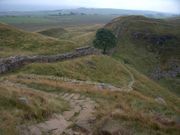
This debate is hardly surprising, given the considerable value that the Robin Hood legend has for local tourism. One of Nottinghamshire's biggest tourist attractions is the Major Oak, a tree that local folklore claims was the home of the legendary outlaw. The age of the tree disproves this myth as it would have been a sapling in the days of Robin Hood. The Sheriff of Nottingham also had jurisdiction in Derbyshire that was known as the "Shire of the Deer", and this is where the Royal Forest of the Peak is found, which roughly corresponds to today's Peak District National Park. The Royal Forest included Bakewell, Tideswell, Castleton, Ladybower and the Derwent Valley near Loxley. The Sheriff of Nottingham possessed property near Loxley, including Hazlebadge Hall, Peveril Castle and Haddon Hall. Mercia, to which Nottingham belonged, came to within three miles of Sheffield City Centre. The supposed grave of Little John can be found in Hathersage, also in the Peak District.
Robin Hood himself is reputed to be buried in the grounds of Kirklees Priory between Brighouse and Mirfield in West Yorkshire. There is an elaborate grave there with the inscription referred to above. The story is that the Prioress was a relative of Robin's. Robin was ill and staying at the Priory where the Prioress was supposedly caring for him. However, she betrayed him, his health worsened, and he eventually died there.
Before he died, he told Little John (or possibly another of his Merry Men) where to bury him. He shot an arrow from the Priory window, and where the arrow landed was to be the site of his grave. The actual grave is within sight of the ruins of the Priory, corresponding to the story. It is behind the Three Nuns pub in Mirfield, West Yorkshire. The nuns supposedly cared for him when he was ill.
The grave can be visited on occasional organised walks, organised by Calderdale Council Tourist Information office.
Further indications of the legend's connection with West Yorkshire (and particularly Calderdale) are noted in the fact that there are pubs called the Robin Hood in both nearby Brighouse and at Cragg Vale; higher up in the Pennines beyond Halifax, where Robin Hood Rocks can also be found. Robin Hood Hill is near Outwood, West Yorkshire, not far from Lofthouse. There is a village in West Yorkshire called Robin Hood, on the A61 between Leeds and Wakefield and close to Rothwell and Lofthouse. With all these references to Robin Hood, it is not surprising that the people of both South Yorkshire and West Yorkshire lay some claim to Robin Hood, who, if he existed, could easily have roamed between Nottingham, Lincoln, Doncaster and right into West Yorkshire. In those days, Sherwood Forest and Barnsdale Forest were probably all one vast forest affording plenty of cover for a band of outlaws.
A British Army Territorial (reserves) battalion formed in Nottingham in 1859 was known as the The Robin Hood Battalion through various reorganisations until the "Robin Hood" name finally disappeared in 1992. With the 1881 Childers reforms that linked regular and reserve units into regimental families ,the Robin Hood Battalion became part of The Sherwood Foresters (Nottinghamshire and Derbyshire Regiment).
List of traditional ballads
Ballads are the oldest existing form of the Robin Hood legends, although none of them are recorded at the time of the first allusions to him, and many are much later. They evince many common features, often opening with praise of the greenwood and relying heavily on disguise as a plot device, but include a wide variation in tone and plot.
- A Gest of Robyn Hode
- Robin Hood and the Monk
- Robin Hood's Death
- Robin Hood and the Potter
- Robin Hood and the Butcher
- Robin Hood and the Curtal Friar
- The Jolly Pinder of Wakefield
- Robin Hood and the Tanner
- Robin Hood and the Tinker
- Robin Hood and the Newly Revived
- The Bold Pedlar and Robin Hood
- Robin Hood and the Prince of Aragon
- Robin Hood and the Scotchman
- Robin Hood and the Ranger
- Robin Hood's Delight
- Robin Hood's Progress to Nottingham
- Robin Hood Rescuing Three Squires
- Robin Hood Rescuing Will Stutly
- Robin Hood and the Bishop
- Robin Hood and the Bishop of Hereford
- Robin Hood and Queen Katherine
- Robin Hood's Chase
- Robin Hood's Golden Prize
- The Noble Fisherman
- Robin Hood's Birth, Breeding, Valor and Marriage
- The King's Disguise, and Friendship with Robin Hood
- Robin Hood and the Golden Arrow
- Robin Hood and the Valiant Knight
- A True Tale of Robin Hood
Some ballads, such as Erlinton, feature Robin Hood in some variants, where the folk hero appears to be added to a ballad pre-existing him and in which he does not fit very well. He was added to one variant of Rose Red and the White Lily, apparently on no more connection than that one hero of the other variants is named "Brown Robin." Francis James Child indeed retitled Child ballad 102; though it was titled The Birth of Robin Hood, its clear lack of connection with the Robin Hood cycle (and connection with other, unrelated ballads) led him to title it Willie and Earl Richard's Daughter in his collection.
Popular culture
Songs, plays, games, and later novels, musicals, films, and TV series have developed Robin Hood and company according to the needs of their times, and the myth has been subject to extensive ideological manipulation.
Robin Hood has become shorthand for a good-hearted bandit who steals from the rich to give to the poor. It is also a proverbial expression for somebody who takes other people's giveaways and gives them to people he or she knows who could use them. This can be called "Robin Hood giving." Many countries and situations boast their own Robin Hood characters; the Category:Robin Hood page tracks them.
The BBC has recently released the second series of Robin Hood starring Jonas Armstrong (Robin), Lucy Griffiths (Marion), Richard Armitage (Guy of Gisborne), and Keith Allen (The Sheriff). The third series will be aired in 2008.
- Starting in 2007, the University of Nottingham will be offering a Masters degree on the subject of Robin Hood.
- Robin Hood became the official mascot of Nottingham Forest Football Club at the beginning of the 2007-08 football season, replacing Sherwood the Bear.


